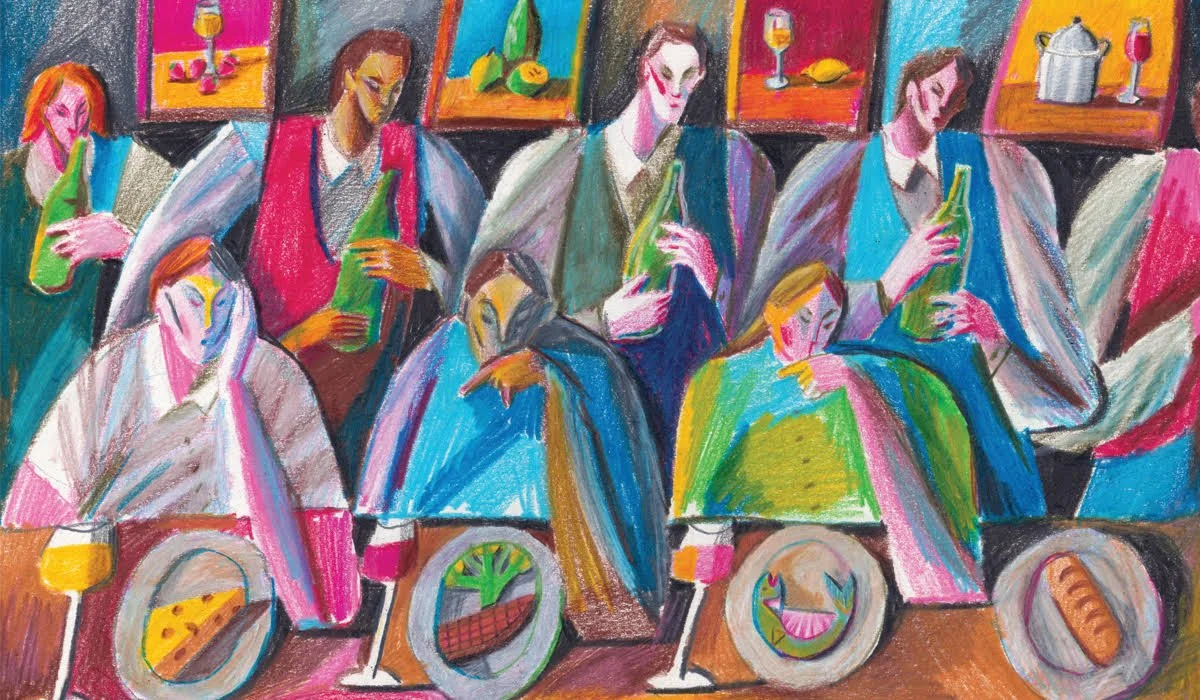Are Traditional Wine Pairings A Thing Of The Past?
Eric Asimov is renouncing traditional, formulaic food & wine pairings… should you do the same?
Written by Eric Asimov
Artwork by Pat Thomas
Drinking wine was never meant to be a daunting intellectual exercise. In fact, wine’s sole purpose is to provide pleasure. And yet, selecting the correct bottle in a wine shop or a restaurant can intimidate even the most courageous souls — never mind the chore of correctly pairing wine to food.
In the realm of “pairings,” we’ve developed the idea that there’s always a right way to do things — which means, there are plenty of wrong ways, too. Conceptualizing pairings has become a minefield in which the fear of a faulty move provokes shame and embarrassment — and that’s one of the most damaging elements of American wine culture.
The truth is, pairing is simple. It’s hard to go wrong. Here’s the secret: Forget about violating sacred rules, or universal principles. With delicious food in front of you, a nice bottle, and good company, all will be well. And with that in mind, how did we get to a point where enjoying food and wine together became fraught with fear?
Thirty-five years ago, when I first joined the food department of The New York Times, a new book about pairing foods and wines was published, “Red Wine With Fish: The New Art of Matching Wine With Food.” The title was a playful heresy that turned the old rule, “white with fish, red with meat” on its head.
Yes, an effort to eliminate hidebound traditions might have been liberating — but instead, the book argued for hyper-specific pairings, as if anything less would be a mistake. It suggested that the best match for pizza, for example, was two-year-old Dolcetto d’Alba, a silly notion for so many reasons including the fact different vintages and different producers will make Dolcetto d’Alba with entirely different characteristics. Which is to say, these people who sought to undermine formulaic rules simply set out a new code of conduct.
Nonetheless, chasing perfect food and wine pairings became a thing. Books, magazines and newspapers all promoted rules and principles to keep in mind. Coursed meals with wine pairings became exorbitantly expensive. The idea was that every dish had one specific wine that would best align.
“Syrah with highly spiced dishes,” one typical article counseled. “Zinfandel with pâtés, mousses and terrines.” No longer could you just choose a wine you liked to enjoy with pizza. Now, you had to account for toppings. Drink the same wine with pepperoni and mushrooms? Perish the thought.
The unconscious — or perhaps boldfaced — message was that selecting the wrong bottle would be a disaster. But it’s nonsense. Let’s please stop this madness. Most foods go well with plenty of different wines, not just one. Almost always, you will not be miserable if you enjoy both elements. The absolute worst thing that can happen is that you will have a good meal, with a good wine. You may not swoon at the combo, but both will still be delicious.
That pizza with the Dolcetto d’Alba? Love it. I also would love Barbera d’Alba, Barolo, Chianti Classico, Lambrusco, Champagne, riesling, or a beer, just to name a few options.
Many people gravitate toward Napa Valley cabernet sauvignon with a steak. That could be great, though I’m pretty picky about Napa cabs. Brunello de Montalcino could be great, too, as would a good syrah, a Fleurie, or even a Jura trousseau, a light-bodied polar opposite among reds to Napa cabernet. Once, in Germany, I was told people enjoyed 20-year-old Auslese Riesling, an aged sweet wine, with steak. It wasn’t bad at all.
Back in the 2000s, it became a thing in Paris to pair oysters with red wines. I did my own experiments, and the combination wasn’t bad, either. I might prefer a Chablis, but a Loire red was pleasant.
Rules like these are not universal. We all have our preferences. So, the absolute best way to learn about pairing food and wine is to…drink wine with food. See what you love together, and what makes little sense to you. Experiment. Change it up. Before long, you’ll have your own perfectly correct ideas about what you like to drink with salmon, sushi, French cheeses, or whatever it is that you’re consuming. This is how you develop confidence, comfort, and instinct.
I’ll admit, for me, there’s one exception: Old, fragile wines, particularly if they are rare and expensive. These require simple foods that will not clash with or overpower subtle, nuanced flavors. Even so, there are so many ways to play around in this territory.
The bottom line is this: Wine is easier than anybody thinks. It exists for our pleasure. If you enjoy drinking, you’re doing it right — and fear of mistakes should never hinder that.

